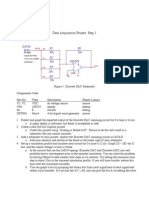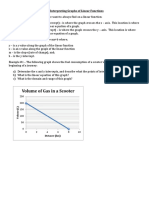The Jordan Loudspeaker Manual Chapter 6
The Jordan Loudspeaker Manual Chapter 6
Uploaded by
Adam PaulCopyright:
Available Formats
The Jordan Loudspeaker Manual Chapter 6
The Jordan Loudspeaker Manual Chapter 6
Uploaded by
Adam PaulOriginal Description:
Copyright
Available Formats
Share this document
Did you find this document useful?
Is this content inappropriate?
Copyright:
Available Formats
The Jordan Loudspeaker Manual Chapter 6
The Jordan Loudspeaker Manual Chapter 6
Uploaded by
Adam PaulCopyright:
Available Formats
PLEASE NOTE THAT THIS CHAPTER IS CURRENTLY BEING REVISED IN VIEW OF OUR LATEST FINDINGS LOUDSPEAKER PARAMETERS It is generally
known, (but rarely admitted), that parametric measurements can be far from reliable. This issue was first raised by the Author in an article entitled THE PARAMETER GAME, published in the Hi Fi News. June 1996 In order to examine the causes of inconsistency, a passive electrical circuit was set up using real components of known values as shown below, This simulated that of a typical loudspeaker as seen by the amplifier. (Fig 18). Tests were made by both direct measurement and by computer derivations using a range of stimulation types and levels. The results were substantially consistent in all tests. Fig 18
Re =5.483ohms, Le = 137.4uH, Cem = 375mfd, Lem = 20mH, Rem =14.5 ohms. Zb= infinite, (driver in free air). Fo (Hz). Direct measurement Computer derived. 58 58.68 Res 6.2 6.8 Rem 14.5 15.2 Qms 2.02 2.10 Qes 0.95 0.98 Qts 0.65 0.67
Check: Fo calculated from given values of Cem and Lem: 58.14Hz The differences in the value of Res and Rem in each case are due to Res being a direct measure of the voice coil resistance and a computer derived a value for motional impedance (omitting the fact that there was no motion). Fig 19 below, shows the plot of the above idealised circuit. The key frequencies are indicated as follows: Mkr1=Fo. Mkr2= Rem. Mkrs 3 and 4= Bandwidth determining Qm
Fig 19 The forgoing demonstrates that apparent inconsistencies are not, in practice, due to acquisition error but due to the effective electrical impedance characteristics of an actual loudspeaker as seen by the amplifier varying with the test conditions. The principle sources of error are the force/displacement non-linearities in both the motor system and the suspension compliance. The impedance at frequencies around Fs, is given by Z = [(2f.Lem 1/2f.Cem)2 - Rem2]1/2 But from Table 1, Lem, Cem and Rem are inversely proportional to B2L2 and, therefore their values are subject to the non-linearity of the driving force. Lem and Rem, are derived from the compliance and internal friction of elastomeric materials. These can vary not only with time and temperature but they also exhibit a non-linear force/displacement characteristic resulting in a variation of resonant frequency with cone amplitude. Due to the combined effects of these non-linearities, the variation of loudspeaker parameters with cone displacement can be quite substantial. Plotting these variables against voice coil current produces S curves, which may or may not have a common centre but will result in a composite curve of the form, Fig: 20. The plot shows a central area that is reasonably linear and a flattening towards each end. The central area will be referred to as the Window of Acceptable Linearity, (WAL). It would, therefore seem logical for all parametric tests to be made within the linear limits of this window which would also be more representative of real programme levels. Yet, remarkably, the unquestioned traditional approach is to test at low levels where it is claImed the distortion is minimal. It clearly is not!
Fig 20
TEST PROCEDURES for IMPROVED ACCURACY Direct Testing of Parameters. The traditional way of direct testing is the constant current method where a relatively high resistor is connected in series between the signal generator and the loudspeaker and the parameters derived from the voltage across the voice coil. This not only severely limits the actual voltage across the coil resulting the errors described above but also limits the normal damping control around the resonant frequency and displacement A preferred method is to use a constant voltage approach using a high quality A.C. milliameter in series between the signal generator and the loudspeaker thereby deriving the impedance parameters from the measured current. This ensures that the performance of the drive unit can be seen to be operating under normal working conditions at every stage. It is also less complicated. The procedure is to set the generator to some very low frequency well below the expected loudspeaker resonance. Advance the generator voltage to a point just below audible distortion. Adjust the frequency to find the point of minimum current. Observe any changes in this frequency by increasing or decreasing the voltage. Find the voltage range over which the frequency of the current minimum is substantially constant. This is the range maximum linearity. To simplify calculations, finely tune the voltage to round-up the current value to two significant figures. Record the values of the applied voltage, (Va), the current (Imin) and the frequency, (Fs). Keeping the voltage constant adjust the frequency upwards to find and record the current maximum (Imax). Ro = Imax/Imin Re = V/Imax Find the frequencies above and below Fs where I = (Imax.Imin)1/2 (Ensure that Xmax is not exceeded at fl). Then: Qm = Fs. Ro1/2/fh-fl. Imn = V / Rdc Imx = V / Imn
Rmx = V / Imn Fh and Fl at (Rmx X Rdc)1/2 = (Imx X Imn)1/2
Qm = Fs ro1/2 /(Fh Fl) Qe = Qm . Rmn / (Rmx Rdc) Qt = Qm Qe / (Qm + Qe) Vas = Vb [{Fb / Fs}2 - 1]. (Note: Due to the problems already mentioned, this may not be accurate). The most reliable method is for Mms to be weighed at the manufacturing stage and Vas calculated. Then: Vas = d.c.A2/(2Fs)2.Mms
Mms = Ma / [(Fs/Fa)2 1] (Not recommended) Efficiency = 7.6 X Fs3 X Vas / Qe X 107 SPL = Sensitivity in dB = 112 + 10 log (efficiency) This approach does require some experienced judgment and the ability to manage basic algebraic operations. It is also time consuming. Computer Derivation of Parameters. Although parameter testing by computer offers a wide range of test options, including varieties of stimuli and levels, it is evident from the foregoing that these may give very differing results. Generally, the tests are made under semi-constant current conditions and the results derived and processed from the voltage across the voice coil. Probably, the most accurate results can be derived from a frequency sweep sometimes referred to as chirp but if this is too fast it can be difficult to determine either the shape or level of the stimulus waveform as it passes through the resonant frequency. The plots below, (Fig: 21), show the effects of taken at three cone displacement levels. The green plot is correctly centred within the WAL. The input levels of the red and blue plots are below and above the WAL respectively. Both show a higher value of Fs indicating the effects of the regions of higher suspension stiffness. The blue plot has a sharper but lower peak due to the coil moving partially outside the linear limits of the magnetic field resulting in reduced damping and efficiency. It should also be noted that, although Fs may be well inside the WAL, the displacement at the lower bandwidth frequency might not be so. It should also be noted that any deformation of the impedance curve would be ignored by a best fit curve resulting in a further source of error. From the experience gained by direct testing, these problems can be largely resolved by the use of a slow sweep time say 3 4 seconds so that the instantaneous voltage level at the resonance can be adjusted and an experienced person can observe any anomalies that may occur in the behaviour of the loudspeaker. This method will produce a fuzzy graph which will be averaged, with reasonable accuracy, by the best- fit curve. (FIGS 22-23) It is worth noting the smooth symmetry of the curves achieved by this method until the minimum current value coincides with the lowest frequency.
Fig 21
Fig 22
Fig 23
You might also like
- Essential Mathematics For The Australian Curriculum Year 8Document17 pagesEssential Mathematics For The Australian Curriculum Year 8iapps0% (1)
- Duncan VCAs Part 3Document8 pagesDuncan VCAs Part 3Ian PressNo ratings yet
- EC2255-Solved Problems in Control Systems PDFDocument182 pagesEC2255-Solved Problems in Control Systems PDFmaheshbabu527100% (3)
- Tetra Sans PS - Glassware / Tubecad - by John BroskieDocument17 pagesTetra Sans PS - Glassware / Tubecad - by John BroskieRafael Frederico TeixeiraNo ratings yet
- Yamaha YST SW515 Subwoofer Review Lo-ResDocument4 pagesYamaha YST SW515 Subwoofer Review Lo-ResLeBackNo ratings yet
- Radiotron Designer's HandbookDocument1,539 pagesRadiotron Designer's HandbookAdam Paul100% (2)
- 1223 Usp 33 MicrobiologyvalidationDocument19 pages1223 Usp 33 Microbiologyvalidationعبدالعزيز بدرNo ratings yet
- Final Report On Op-Amp To OTA ConversionDocument41 pagesFinal Report On Op-Amp To OTA ConversionAman VatsNo ratings yet
- Analysis of Opamp Using PspiceDocument19 pagesAnalysis of Opamp Using PspiceKarThiNo ratings yet
- Vented. Box Loudspeaker Systems Part I1: Large-Signal AnalysisDocument7 pagesVented. Box Loudspeaker Systems Part I1: Large-Signal AnalysisEclys MontenegroNo ratings yet
- Yamaha Rx-V3067 Rx-A3010 SCHDocument89 pagesYamaha Rx-V3067 Rx-A3010 SCHCleber MouraNo ratings yet
- The Jordan Loudspeaker Manual Chapter 2Document4 pagesThe Jordan Loudspeaker Manual Chapter 2Adam PaulNo ratings yet
- ESE 568: Mixed Signal Design and Modeling Basic 2-Stage OpampDocument13 pagesESE 568: Mixed Signal Design and Modeling Basic 2-Stage OpampchandanaNo ratings yet
- Schematic Diagram For Model 2216: All VersionsDocument1 pageSchematic Diagram For Model 2216: All VersionsZa RacsoNo ratings yet
- Pro Co Rat AnalysisDocument16 pagesPro Co Rat AnalysisgianmarcoNo ratings yet
- Tda 2005 DatasheetDocument25 pagesTda 2005 DatasheetRuben NinaNo ratings yet
- Electronic Projects: 18W Audio AmplifierDocument2 pagesElectronic Projects: 18W Audio AmplifierLaurentiu DraganNo ratings yet
- Amplifier Frequecny ResponseDocument63 pagesAmplifier Frequecny ResponseNuman khanNo ratings yet
- 1308 - 12297 A New Class-D Stereo Audio Amplifier Using Direct Speaker Current ControlDocument3 pages1308 - 12297 A New Class-D Stereo Audio Amplifier Using Direct Speaker Current Controlrodales56No ratings yet
- Audio Transformer InductanceDocument8 pagesAudio Transformer InductanceCharles AustinNo ratings yet
- Analisis de Circuito Big MuffDocument10 pagesAnalisis de Circuito Big MuffNacho ConsolaniNo ratings yet
- Class D Tutorial 2Document74 pagesClass D Tutorial 2Gerardo Mendez CamarilloNo ratings yet
- Baxandall Tone ControlDocument7 pagesBaxandall Tone ControlSheeNo ratings yet
- Hfe Krell Kav-300i SchematicsDocument3 pagesHfe Krell Kav-300i SchematicsDRF254No ratings yet
- Basic VLSI SlidesDocument91 pagesBasic VLSI SlidesDivya AhujaNo ratings yet
- Nad 310 Integrated Amplifier SchematicDocument2 pagesNad 310 Integrated Amplifier SchematicRosevereNo ratings yet
- Sample Submissions For Test Bench: ND RDDocument7 pagesSample Submissions For Test Bench: ND RDfb79No ratings yet
- Baxandall Tone Controls - Elliott Sound (Org)Document13 pagesBaxandall Tone Controls - Elliott Sound (Org)nui338100% (1)
- HotFET Pre J-FET Audio Preamplifier SchematicsDocument6 pagesHotFET Pre J-FET Audio Preamplifier SchematicsJefri ErlanggaNo ratings yet
- GQX 3102Document2 pagesGQX 3102yohanaNo ratings yet
- Borbely On Line AmpsDocument26 pagesBorbely On Line Ampsehsannemesis6No ratings yet
- New Application of Evanescent Mode Waveguide To Filter DesignDocument9 pagesNew Application of Evanescent Mode Waveguide To Filter DesignhazardasssNo ratings yet
- Transistor Active High Pass Filter Electronics NotesDocument2 pagesTransistor Active High Pass Filter Electronics NotesRenato DeákNo ratings yet
- Lecture 6 - 7 Power - AmplifiersDocument77 pagesLecture 6 - 7 Power - AmplifierssunilsheelavantNo ratings yet
- LT Spice - Transformers - (By Mike Engelhardt)Document2 pagesLT Spice - Transformers - (By Mike Engelhardt)kimbalsummers801No ratings yet
- DB ConceptsDocument29 pagesDB ConceptsSasanka Sekhar PaniNo ratings yet
- Descrete Op Amp PapadopouDocument8 pagesDescrete Op Amp PapadopoupapadopouNo ratings yet
- Lecture 5: Transformers (Continued)Document16 pagesLecture 5: Transformers (Continued)Aldiansyah dtsNo ratings yet
- Matlab 8Document12 pagesMatlab 8M Azeem100% (1)
- Emg FiltersDocument48 pagesEmg FiltersTeheranNo ratings yet
- BJT IC Design: Rochester Institute of Technology Microelectronic EngineeringDocument41 pagesBJT IC Design: Rochester Institute of Technology Microelectronic EngineeringPauloConstantinoNo ratings yet
- Unit V - Active FiltersDocument14 pagesUnit V - Active Filterseshwar_worldNo ratings yet
- VSX-407RDS, - 607RDSDocument58 pagesVSX-407RDS, - 607RDSmichal_lysyNo ratings yet
- AmplifierDocument68 pagesAmplifierशुभम तिवारीNo ratings yet
- Simple Understanding DecibelsDocument2 pagesSimple Understanding DecibelsffortisimoNo ratings yet
- Opamp Desiging Project ReportDocument6 pagesOpamp Desiging Project ReportTarun PrakashNo ratings yet
- A Class-A Amplifier For Home Constructors: PART ONE - Design Considerations and A Circuit DescriptionDocument7 pagesA Class-A Amplifier For Home Constructors: PART ONE - Design Considerations and A Circuit DescriptionisaijhabinNo ratings yet
- Mike HarwoodDocument26 pagesMike HarwoodPraveen AndrewNo ratings yet
- Advanced Current Mirrors and Opamps: Hossein ShamsiDocument45 pagesAdvanced Current Mirrors and Opamps: Hossein ShamsiChristian Montano GalvezNo ratings yet
- Atcl 3 PDFDocument8 pagesAtcl 3 PDFgheo23No ratings yet
- ADC DAC DiscreteDocument4 pagesADC DAC Discretegersonymayer100% (1)
- VX-2100 2200 VHF EuDocument68 pagesVX-2100 2200 VHF EudenariraNo ratings yet
- Analog Filter Design Demystified: The Theory of Analog ElectronicsDocument11 pagesAnalog Filter Design Demystified: The Theory of Analog ElectronicsSanjay Parelkar100% (1)
- A Biblia Do P.A. - Sonorizacao - The P.A. Bible - em Ingles PDFDocument79 pagesA Biblia Do P.A. - Sonorizacao - The P.A. Bible - em Ingles PDFCarlos Henrique Otoni FerrerNo ratings yet
- Active Hi-Fi LoudspeakersDocument17 pagesActive Hi-Fi LoudspeakersCarioquenhoNo ratings yet
- EE609 Lect-6-2023 Horn ReflectorDocument25 pagesEE609 Lect-6-2023 Horn Reflectorgargbansalpulkit100% (1)
- Danley TappedDocument8 pagesDanley TappedmenombreesdanielNo ratings yet
- Main Article: FM Broadcast BandDocument22 pagesMain Article: FM Broadcast BandKristian MamarilNo ratings yet
- WCDMA: Requirements and Practical DesignFrom EverandWCDMA: Requirements and Practical DesignRudolf TannerNo ratings yet
- Transmission Lines in Digital Systems for EMC PractitionersFrom EverandTransmission Lines in Digital Systems for EMC PractitionersNo ratings yet
- Microwave Filters for Communication Systems: Fundamentals, Design, and ApplicationsFrom EverandMicrowave Filters for Communication Systems: Fundamentals, Design, and ApplicationsNo ratings yet
- The Jordan Loudspeaker Manual Chapter 5Document2 pagesThe Jordan Loudspeaker Manual Chapter 5Adam PaulNo ratings yet
- The Jordan Loudspeaker Manual Chapter 2Document4 pagesThe Jordan Loudspeaker Manual Chapter 2Adam PaulNo ratings yet
- The Jordan Loudspeaker Manual Chapter 1Document4 pagesThe Jordan Loudspeaker Manual Chapter 1Adam Paul100% (1)
- Interdisciplinary Unit PlanDocument6 pagesInterdisciplinary Unit Planapi-276580201No ratings yet
- Facile and Low Cost Temperature Compensated Humidity Sensor and Signal Conditioning SystemDocument9 pagesFacile and Low Cost Temperature Compensated Humidity Sensor and Signal Conditioning SystembackupzalfaaNo ratings yet
- 346 Lab ManualDocument26 pages346 Lab ManualsazinaNo ratings yet
- Chapter 4 - Additional Analysis Techniques SlidesDocument52 pagesChapter 4 - Additional Analysis Techniques SlidesDouglas OngomNo ratings yet
- Navdeep Gill, Patrick Hall - An Introduction To Machine Learning Interpretability (2018, O'Reilly Media, Inc.) PDFDocument45 pagesNavdeep Gill, Patrick Hall - An Introduction To Machine Learning Interpretability (2018, O'Reilly Media, Inc.) PDFWirawan SetialaksanaNo ratings yet
- ME Math 8 Q1 0303 SGDocument22 pagesME Math 8 Q1 0303 SGHarvey BacudNo ratings yet
- What Is Geometric Nonlinearity - COMSOLDocument15 pagesWhat Is Geometric Nonlinearity - COMSOLLakshman ReddyNo ratings yet
- DLL Math 8 Quarter 2 Week 4Document6 pagesDLL Math 8 Quarter 2 Week 4Jay Paul T. Badenas100% (1)
- Lecture-5 - Nonlinear Systems - 1Document17 pagesLecture-5 - Nonlinear Systems - 1Everly NNo ratings yet
- MPX2010 PDFDocument17 pagesMPX2010 PDFEnte Bliss OnixNo ratings yet
- Domain and Range Functions Worksheets With AnswersDocument12 pagesDomain and Range Functions Worksheets With AnswersChristine Niña Agdeppa0% (1)
- Grade 10 Mathematics ReviewerDocument3 pagesGrade 10 Mathematics ReviewerPhillip GabaynoNo ratings yet
- 5.7 Interpreting Graphs of Linear Functions 2Document3 pages5.7 Interpreting Graphs of Linear Functions 2Angel LawsonNo ratings yet
- Linearity and Sensitivity Error in The Use of Single Strain Gages With Voltage-Fed and Current-Fed CircuitsDocument7 pagesLinearity and Sensitivity Error in The Use of Single Strain Gages With Voltage-Fed and Current-Fed CircuitsGilbertoAndresDuarteNo ratings yet
- Semi-Detailed Lesson PlanDocument5 pagesSemi-Detailed Lesson PlanGERLYN GULLOSNo ratings yet
- E317-94 UT Evaluating Equip Performance PDFDocument11 pagesE317-94 UT Evaluating Equip Performance PDFjalcazar77100% (1)
- MPX10DPDocument8 pagesMPX10DPsuperpuma86No ratings yet
- Math 531 - Partial Differential Equations: Separation of VariablesDocument32 pagesMath 531 - Partial Differential Equations: Separation of VariablesVideo Editing TimeNo ratings yet
- InstrumentationDocument34 pagesInstrumentationAmr AliNo ratings yet
- 8th Grade Study Island Pathway RecordingsDocument3 pages8th Grade Study Island Pathway Recordingsapi-293256153No ratings yet
- Uji LinieritasDocument3 pagesUji LinieritasIda Surtiana20No ratings yet
- Lecure-1 Introduction To Biomedical Instrumentation System - 4Document41 pagesLecure-1 Introduction To Biomedical Instrumentation System - 4Noor Ahmed80% (5)
- BASIC InstrumentationDocument13 pagesBASIC InstrumentationVignesh RajanNo ratings yet
- 2.3 Linear Approximation of Physical SystemsDocument3 pages2.3 Linear Approximation of Physical SystemsramNo ratings yet
- Current Transducer LF 510-S 500 ADocument7 pagesCurrent Transducer LF 510-S 500 AAhmad Fahmi AriefNo ratings yet
- UT Chapter 11Document70 pagesUT Chapter 11knizam1971100% (1)



























































































